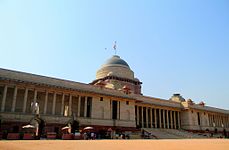President of India
The president of India (IAST: Bhārat kē Rāṣṭrapati) is the head of state of the Republic of India. The president is the nominal head of the executive,[a] the first citizen of the country, as well as the supreme commander of the Indian Armed Forces. Droupadi Murmu is the 15th and current president, having taken office from 25 July 2022.
For a list of presidents, see List of presidents of India.President of India
-
- Hon’ble President
(Within India)[1] - Her Excellency
(Outside India)[1] - The Honourable
(Within Commonwealth)
- Hon’ble President
POI
Five years
No restriction on renewal
Constitution of India (Article 52)
Monarch of India and his representative the Governor-General of India
26 January 1950
• ₹500,000 (US$6,000) (per month)
• ₹6,000,000 (US$72,000) (annually)[2]
The office of president was created when India became a republic on 26 January 1950 when its constitution came into force. The president is indirectly elected by an electoral college comprising both houses of the Parliament of India and the legislative assemblies of each of India's states and territories, who themselves are all directly elected by the citizens.
Article 53 of the Constitution of India states that the president can exercise their powers directly or by subordinate authority, though all of the executive powers vested in the president are, in practice, exercised by the prime minister heading the Council of Ministers.[3] The president is bound by the constitution to act on the advice of the council and to enforce the decrees passed by the Supreme Court under article 142.
Origin
India achieved independence from the British on 15 August 1947, initially as a dominion within the Commonwealth of Nations with George VI as king, represented in the country by a governor-general.[4] Following independence, the Constituent Assembly of India, under the leadership of B. R. Ambedkar, undertook the process of drafting a completely new constitution for the country. The Constitution of India was eventually enacted on 26 November 1949 and came into force on 26 January 1950,[5]: 26 making India a republic.[6]: 9 The offices of monarch and governor-general were replaced by the new office of President of India, with Rajendra Prasad as its first incumbent.[6]: 1 India retained its Commonwealth membership per the London Declaration, recognising The King as "the symbol of the free association of its independent member nations and as such the Head of the Commonwealth."[7]
The Indian constitution accords to the president the responsibility and authority to defend and protect the Constitution of India and its rule of law.[8] Invariably, any action taken by the executive or legislature entities of the constitution shall become law only after the president's assent. The president shall not accept any actions of the executive or legislature which are unconstitutional. The president is the foremost, most empowered and prompt defender of the constitution (Article 60), who has pre-emptive power for ensuring constitutionality in the actions of the executive or legislature. The role of the judiciary in upholding the Constitution of India is the second line of defence in nullifying any unconstitutional actions of the executive and legislative entities of the Indian Union.
Selection process
Eligibility
Article 58 of the constitution sets the principal qualifications one must meet to be eligible to the office of the president. A president must be:
A person shall not be eligible for election as president if they hold any office of profit under the Government of India or the Government of any State or any local or other authority subject to the control of any of the said Governments.
Certain office-holders, however, are permitted to stand as presidential candidates. These are:
In the event that the vice president, a state governor or a minister is elected president, they are considered to have vacated their previous office on the date they begin serving as president.
A member of parliament or a State Legislature can seek election to the office of the president but if they are elected as president, they shall be deemed to have vacated their seat in parliament or State Legislature on the date on which they enter upon their office as President [Article 59(1)].
Article 57 provides that a person who holds, or who has held, office as president shall, subject to the other provisions of this constitution, be eligible for re-election to that office.
Under the Presidential and Vice-Presidential Elections Act, 1952,[44] a candidate to be nominated for the office of president needs 50 electors as proposers and 50 electors as seconders for their name to appear on the ballot.[45]
The president of India used to receive ₹10,000 (US$100) per month per the Second Schedule of the constitution. This amount was increased to ₹50,000 (equivalent to ₹230,000 or US$2,700 in 2023) in 1998. On 11 September 2008, the Government of India increased the salary of the president to ₹1.5 lakh (equivalent to ₹4.2 lakh or US$5,000 in 2023). This amount was further increased to ₹5 lakh (equivalent to ₹6.7 lakh or US$8,000 in 2023) in the 2018 Union budget of India. However, almost everything that the president does or wants to do is taken care of by an annual ₹225 million (equivalent to ₹630 million or US$7.5 million in 2023) budget that the Government allots for their upkeep.[52] Rashtrapati Bhavan, the president's official residence, is the largest Presidential palace in the world.[53][54] The Rashtrapati Nilayam at Bolarum, Hyderabad and Retreat Building at Chharabra, Shimla are the official Retreat Residences of the president of India. The official state car of the president is a custom-built heavily armored Mercedes Benz S600 (W221) Pullman Guard.
The former presidents and widows and widowers of presidents are eligible for pension, furnished accommodation, security, various allowances, etc.[55]






